
A hairstyle, hairdo, haircut or coiffure refers to the styling of hair, usually on the human scalp. Sometimes, this could also mean an editing of facial or body hair. The fashioning of hair can be considered an aspect of personal grooming, fashion, and cosmetics, although practical, cultural, and popular considerations also influence some hairstyles.

A barber is a person whose occupation is mainly to cut, dress, groom, style and shave men's and boys' hair or beards. A barber's place of work is known as a "barbershop" or a "barber's". Barbershops are also places of social interaction and public discourse. In some instances, barbershops are also public fora. They are the locations of open debates, voicing public concerns, and engaging citizens in discussions about contemporary issues.

Scissors are hand-operated shearing tools. A pair of scissors consists of a pair of metal blades pivoted so that the sharpened edges slide against each other when the handles (bows) opposite to the pivot are closed. Scissors are used for cutting various thin materials, such as paper, cardboard, metal foil, cloth, rope, and wire. A large variety of scissors and shears all exist for specialized purposes. Hair-cutting shears and kitchen shears are functionally equivalent to scissors, but the larger implements tend to be called shears. Hair-cutting shears have specific blade angles ideal for cutting hair. Using the incorrect type of scissors to cut hair will result in increased damage or split ends, or both, by breaking the hair. Kitchen shears, also known as kitchen scissors, are intended for cutting and trimming foods such as meats.
In computer science, the sleeping barber problem is a classic inter-process communication and synchronization problem that illustrates the complexities that arise when there are multiple operating system processes.

A bob cut, also known as a bob, is a short to medium length haircut, in which the hair is typically cut straight around the head at approximately jaw level, but no longer than shoulder-length, often with fringe or bangs at the front. The standard bob cut exposes the back of the neck and keeps all of the hair well above the shoulders.
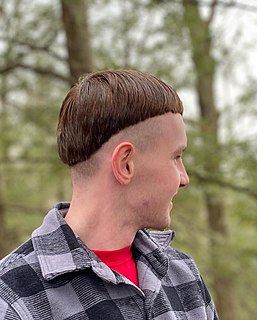
A bowl cut or mushroom cut is a simple haircut where the front hair is cut with a straight fringe and the rest of the hair is left longer, the same length all the way around, or else the sides and back are cut to the same short length. It is named so because in medieval times, when it was popular in Europe, a bowl would be placed on the head and then used as a cutting guide to trim the hair.

Let's trim our hair in accordance with the socialist lifestyle is a television program that was part of a North Korean government propaganda campaign promulgating grooming and dress standards in 2004–2005.
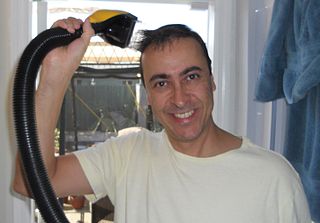
The Flowbee is an electrically powered vacuum cleaner attachment made for cutting hair. It was developed and filed for patent in 1986 by Rick E. Hunts, a San Diego, California, US carpenter. US patent 4679322 was granted in 1987 and the product marketed since 1988. Hunt initially sold the Flowbees out of his garage before finding success with live demonstrations at a county fair. The product was advertised as being capable of performing "hundreds of precision layered haircuts" in frequently aired late-night television infomercials. By 2000, two million Flowbees had been sold.

The Caesar cut is a hairstyle with short, horizontally straight cut bangs. The hair is layered to around 2–5 cm all over. It is named after the Roman Emperor Tiberius Caesar Augustus, whose images frequently depict him wearing his hair in such a manner. This haircut first became fashionable among Western boys and men in the 1950s.
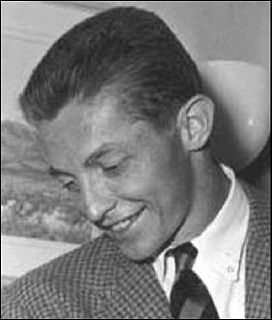
A "flattop" is a type of short haircut where the hair on the top of the head is usually standing upright and cut to form a flat-appearing deck. This deck may be level, or it may be upward or downward sloping. This type of haircut is usually performed with electric clippers, either freehand or using the clipper-over-comb method.
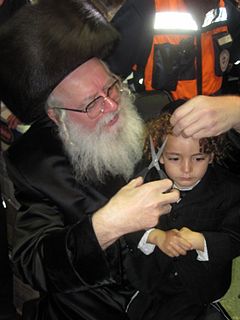
Upsherin, Upsheren, Opsherin or Upsherinish is a haircutting ceremony observed by a wide cross-section of Jews and is particularly popular in Haredi Jewish communities. It is typically held when a boy turns three years old. Among those who practice the upsherin, the male infant does not have his hair cut until this ceremony.

The first haircut for a human has special significance in certain cultures and religions. It can be considered a rite of passage or a milestone.
Layered hair is a hairstyle that gives the illusion of length and volume using long hair for the illusion of length and short hair for volume, as an easy style to manage. Hair is arranged into layers, with the top layers cut shorter than the layers beneath. This allows the tips of the top layers to blend seamlessly with layers beneath.
"The Barber" is the 72nd episode of the NBC sitcom Seinfeld. It is the eighth episode of the fifth season, and first aired on November 11, 1993. The episode deals with Jerry's struggle to get a good haircut without offending his usual barber, who is bad at cutting hair. Meanwhile, George begins showing up to work at a company which he is not sure has actually hired him.
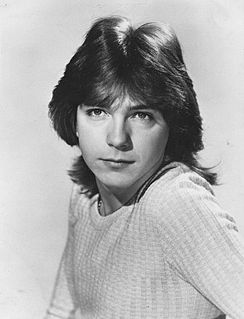
A shag cut is a hairstyle that has been layered to various lengths. It was created by the barber Paul McGregor. The layers are often feathered at the top and sides. The layers make the hair full around the crown, and the hair thins to fringes around the edges. This unisex style became popular after being worn by various celebrities, including Joan Jett, David Bowie, Mick Jagger, Rod Stewart, David Cassidy, Jane Fonda, and Florence Henderson in the early 1970s. During the 1990s, Jennifer Aniston popularized "The Rachel" hairstyle, and Meg Ryan wore a shag in the early 2000s. The haircut had a resurgence in popularity during the early 2020s.
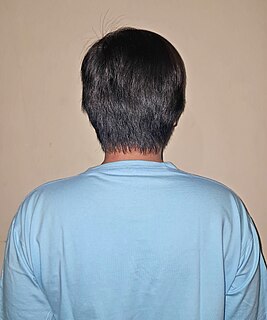
Short hair refers to any haircut with little length. It may vary from above the ears to below the chin. If a man's hair reaches the chin, it may not be considered short. For a woman, however, short varies from close-cropped to just above the shoulders. Different styles of short hair include the bob cut, the crop and the pixie cut.

A butch cut is a type of haircut in which the hair on the top of the head is cut short in every dimension. The top and the upper portion of the back and sides are cut the same length, generally between 1⁄4 and 1⁄2 inch, following the contour of the head. The hair below the upper portion of the sides and back of the head is tapered short or semi-short with a clipper, in the same manner as a crew cut. A variant form may have a slight graduation of the top hair longer from back to front or a quickly graduated bit of hair at the front hairline to achieve a little flip up of the hair at the forehead. A butch that is cut at less than 1⁄4 inch on top may be referred to as a burr. A butch that is cut at 1⁄4 inch or longer on top, and especially one that shows natural curl, depending on length, may be referred to as a short brush cut or brush cut. Butch cuts are traditionally groomed with hair control wax, commonly referred to as butch wax.

The undercut is a hairstyle that was fashionable from the 1910s to the 1940s, predominantly among men, and saw a steadily growing revival in the 1980s before becoming fully fashionable again in the 2010s. Typically, the hair on the top of the head is long and parted on either the side or center, while the back and sides are buzzed very short. It is closely related to the curtained hair of the mid-to-late 1990s, although those with undercuts during the 2010s tended to slick back the bangs away from the face.
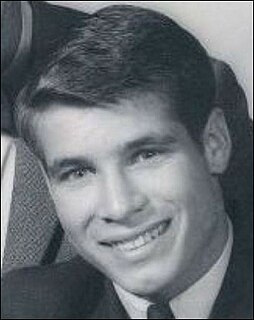
A regular haircut, in Western fashion, is a men's and boys' hairstyle that has hair long enough to comb on top, a defined or deconstructed side part, and a short, semi-short, medium, long, or extra long back and sides. The style is also known by other names including taper cut, regular taper cut, side-part and standard haircut; as well as short back and sides, business-man cut and professional cut, subject to varying national, regional, and local interpretations of the specific taper for the back and sides.
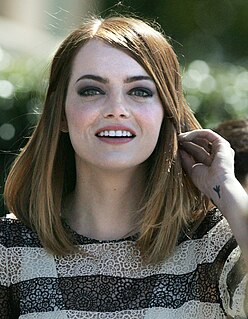
A lob or long bob is a form of haircut and a variant of bob cut. The length is between long hair and a bob cut.
















